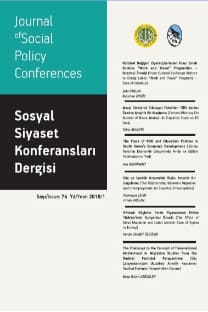Mülkiyetin Tarihsel Gelişimi Üzerine Bir Deneme
Mülkiyet, insanlık tarihi boyunca gerek bireylerin gerekse de toplumların ilgi odağı olmuş, tarihsel süreçte ise birçok dönüşüme uğramıştır. Bu dönüşüm dünya tarihinde yaşanan ekonomik, siyasi ve dini sistemlerden etkilenerek günümüzdeki halini almıştır. Bu nedenle mülkiyet kavramının yaşadığı dönüşümünü inceleyebilmek için insanlık tarihinde yaşanan önemli olaylara, ekonomik, siyasi ve dini sistemlere de bakma gerekliliği ortaya çıkmaktadır. Bu bağlamda, çalışmada Mısır Takviminden günümüze mülkiyet kavramı söz konusu perspektifte ortaya konmuş, yapılan literatür araştırması sonucunda elde edilen bulgularla kronolojik bir deneme çalışması gerçekleştirilmiştir.
Anahtar Kelimeler:
Mülkiyet kavramı, Özel mülkiyet, Ortak mülkiyet
An Experiment on the Historical Development of Prope
Property has been the center of attention of both individuals and societies throughout world history and has undergone many transformations in the historical process. This transformation has been affected by economic, political and religious systems in world history. Therefore, in order to examine the transformation of the concept of property, it is necessary to contextualise the important events in the history of the world in terms of economic, political and religious systems. In this context, the concept of property has been put forward in the said perspective from the Egyptian calendar to the present and a chronological study has been, carried out with findings obtained from the literature research.
Keywords:
The concept of property, Private property, Joint property,
___
- Arnold, D. (1995). Coğrafi keşifler tarihi. Çev Osman Bahadır. İstanbul: Alan Yayıncılık.
- Barber, M. (2006). Yeni şövalyelik tapınak tarikatinin tarihi. İstanbul: Kabalcı Yayınevi. Briant, P. (2002). From Cyrus to Alexander a history of the Persian Empire. Indiana: Histoire de I’Empire perse by Librairie Artheme Fayard.
- Brier, B. (1999). The history of Ancient Egypt course guidebook. US: The Great Courses.
- Chapra, M. U. (2006). İbn-i Haldûn’un gelişme teorisi günümüz islâm dünyasının düşük performansına izahta yardımcı olur mu? İslam Araştırmaları Dergisi, 16, 205–243.
- Collins, J. C. (2007). The Hittites and their world. Atlanta: Society of Biblical Literature. Dalkılınç, İ. (1998). İbn-i Haldun’un mülkiyet anlayışı. Sosyoloji Konferansları Dergisi, 25, 71–91.
- Dougherty, R. J. (2003). Catholicism and the Economy: Augustine and Aquinas on Property Ownership. Journal of Markets & Morality, 6(2), 479–495.
- Erdem, B. (2012). İktisadi düşünceler tarihi. Eskişehir: Anadolu Üniversitesi Yayınları, Yayın No: 2617.
- Ersoy, A. (2008). İktisadi teoriler ve düşünceler tarihi. Ankara: Nobel Yayın Dağıtım.
- Etgü, M. A. (2008). Marksist mülkiyet yaklaşımı. Erzincan Üniversitesi Hukuk Fakültesi Dergisi, 12, 113–133.
- Faulkner, N. (2012). Marksist dünya tarihi neandertallerden neoliberallere. İstanbul: Yordam Kitap.
- Finkelstein, I. (2003). the forgotten kingdom the archaelogy and history of northern ısrael. Atlanta: The Society of Biblical Literature.
- Friedman, H. H., & Langbert, M. (2000). Abraham as a transformational leader. E- Journal of Leadership Studies, 7, 88–95.
- Güriz, A. (1969). Teorik açıdan mülkiyet sorunu. Ankara: Ankara Üniversitesi Hukuk Fakültesi Yayınları.
- Hacak, H. (2005). İslâm hukuk düşüncesinde özel mülkiyet anlayışı. Marmara Üniversitesi İlâhiyat Fakültesi Dergisi, 29, 99–120.
- Hobsbawn, E. J. (2003). Sanayi ve imparatorluk. (A. Ersoy, çev), Ankara: Dost Kitapevi.
- Kılıç, R. ve Demirçelik, M. (2011). Mülkiyet kavramının tarihsel gelişim sürecinde ortaçağ ve reform hareketi. Dumlupınar Üniversitesi Sosyal Bilimler Dergisi, 30, 181–190.
- King, F. (2008). A Comprehensive Chronicle of World History –136,000 To +1399 The Rise Of Civilizations And Cultures, A Comprehensive Chronicle of World History. I of IV, 1-264.
- Kopier, K. (2010). Mesopotamia the world’s earliest civilisation. New York: Britannica Educational Publishing.
- Köktürk, E. (2004). Haritacılığın 5000 yıllık yürüyüşü tarihsel süreç gelişme dinamikleri I. bölüm: Babiller’den antik çağa. Jeodezi, Jeoinformasyon ve Arazi Yönetimi Dergisi, 90, 32–35.
- Kuiper, K. (2011). Ancient Rome from Romulus and Remus to the visigoth invasion. New York: Britannica Educational Publishing.
- Leick, G. (2003). Historical dictionary of Mesopotamia. UK: The Scarecrow Press, Inc.
- Marx, K., & Friedrich, E. (1998). Komünist parti manifestosu. Ankara: Sol Yayınları.
- Marriot, E. (2015). Bir nefeste dünya tarihi. (Yılgür E., Çev.). İstanbul: Maya Kitap.
- Podany, A. H., (2018). Ancient Mesopotamia life in the Gradle of civilization course guidebook. US: The Great Courses.
- Ponting, C. (2011). Yeni bir bakış açısıyla dünya tarihi. İstanbul: Alfa Basım Yayın.
- Roosevelt, C. H. (2012). Iron Age Western Anatolia: The Lydian Empire and Dynastic Lycia, (D. Potts, çev). A Companion to the Archaeology of the Ancient Near East. Blackwell Companions to the Ancient World. MA: Blackwell Publishing.
- Scott, J. C. (2018). The Phoenicians and the Formation of the Western World. Comparative Civilizations Review, 78, 24–40.
- Şeker, S. ve Şeker F. (2019). Token’lardan çı̇vı̇ yazılı kı̇l tabletlere: Yazının ı̇cadında muhasebenı̇n ı̇zlerı̇. Accounting and Financial History Research Journal. 16, 86–110.
- Smith, A. (1997). Ulusların zenginliği. (Yunus A, Bakırcı M., Çev.), İstanbul: Alan Yayıncılık.
- Topal, A. (2007). Latin Amerikayı anlamak. İstanbul: Yordam Kitap.
- Ülgen, P. (2010). Ortaçağ Avrupasında Feodal Sisteme Genel Bir Bakış. Mukaddime, 1, 1–17.
- Warrier, M. (2007). Faith Guides for Higher Education A Guide to Hinduism. UK: Subject Centre for Philosophical and Religious Studies.
- ISSN: 1304-0103
- Yayın Aralığı: Yılda 2 Sayı
- Başlangıç: 1948
- Yayıncı: İstanbul Üniversitesi Yayınevi
Sayıdaki Diğer Makaleler
İşe Adanmışlık ve Örgütsel Özdeşleşme İlişkisinin Performans Algısına Etkisi Üzerine Bir Araştırma
100.Yılında Uluslararası Çalışma Örgütü: Değişen Koşullarda Politika Tercihleri ve Yönelimler
Sosyal Siyaset Konferansları Dergisi ve Uluslararası Çalışma Örgütü (ILO)
Impediments to Civil Registration: The case of Somali Regional State in Ethiopia
Uluslararası Çalışma Örgütü ve Enformasyon Sistemleri İnovasyonu
Avrupa İşçi Sendikaları Konfederasyonunun (ETUC) Küreselleşme Bağlamında Değerlendirilmesi
